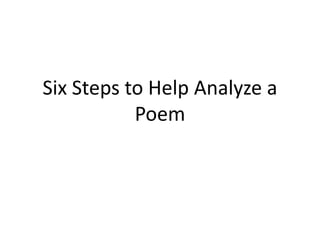
Six steps to help analyze a poem
- 1. Six Steps to Help Analyze a Poem
- 2. Step 1: Consider the Title • Remember that the poem’s title is the author’s first communication with the reader; therefore, spend a moment considering what meaning the poet is suggesting by their choice of words. • What is the poet communicating about the subject of the poem, and what is the poet’s attitude about their subject? • What possible connotations does the title have? • What images or pictures come to mind? What do you expect from the title?
- 3. Step 2: Study the form of the poem on the page • Is the poem arranged in stanzas? If so, how many? What relationship might there be between the number of stanzas and the subject matter of the poem? • Are the stanzas of a standard length (same number of lines in each stanza), or do the stanzas vary in length? What possible meaning does this suggest about the relationship or importance of the ideas in the stanzas? • Consider the length of the lines. Are the lines uniform in length? Are they short, long, varied in length? What possible meaning does this suggest about the relationship or importance of the ideas in the stanzas?
- 4. Step 2: Study the form of the poem on the page, cont’d. • Look for any unusual capitalization. Remember that it is standard in poetry to capitalize the first letter of each line. If there are any words unusually capitalized, what possible meaning does the capitalization have? • Examine the punctuation used. What types of punctuation are used? Commas? Periods? Exclamation points? Question marks? Dashes? What does the use of punctuation suggest about the poet’s ideas? • Look for any end rhyme. Look at the last word in each line for a regular pattern of rhyming. Remember that rhyme forms a connection between words. What possible meaning is the poet after by forming a connection between the words which rhyme?
- 5. Step 3: Read the poem aloud. • Remember that a poet is communicating through the sounds of the words they select, as well as through the literal meaning of the words; therefore, it is essential that you read the poem aloud to fully appreciate the poet’s use of sound. • Listen to the sounds. Are the sounds smooth or harsh? Do you have any emotional reaction to particular words or sounds? • Do you hear any repetition of particular sounds? What might the poet be trying to communicate through the repetition?
- 6. Step 3: Read the poem aloud, cont’d. • Listen to the rhythm of the poem. Is there a standard rhythmical pattern? Is there a recurring beat or rhythm? What’s the emotional reaction to the rhythm? • Listen for any internal rhyme. (Internal rhyme is when a word within a line rhymes with the word at the end of the line.) Is there a connection between the words which are being rhymed? What might it be? • Do you have any first impressions of the poem’s subject matter and tone from the oral reading?
- 7. Step 4: Read the poem line by line. • Once you have carefully completed Steps 1, 2, and 3, you are ready for the most thorough reading of the poem. During this step you read the poem line by line and sentence (if punctuated with periods) by sentence. As you read, consider all the possible meanings of the words. Do not immediately assume that your first reaction is the only possible meaning. Remember the poet has carefully selected and arranged the words to reveal the relationship of their ideas. The poet has chosen words consciously to reveal the greatest meaning in the fewest words; therefore, you must read precisely and thoroughly to understand their ideas.
- 8. Step 4: Read the poem line by line, cont’d. • Remember to consider each stanza as a unit. What divisions has the poet made in their subject matter? What is the relationship between the ideas in each stanza? Why are the stanzas arranged in sequence as they are? What meaning does each stanza have?
- 9. Step 5: Analyze the entire poem. • Consider the entire poem as a unit, recalling what insights you have gained from Steps 1-4. • What is the poet’s intention? What vision did they present in the poem? What idea did the poet convey? What meaning does the poem have? • What is the total effect of the poem?
- 10. Step 6: Evaluation of the poem. • Evaluate the poem objectively. Try to distance yourself. Avoid personal prejudices. Is the poem well written? Does the poet use their language and form effectively in communicating their ideas? • Evaluate the poem subjectively. This is your personal response to the idea, form, and sound of the poem. Did you like the poem? Did the poet communicate something which was relevant to you?
